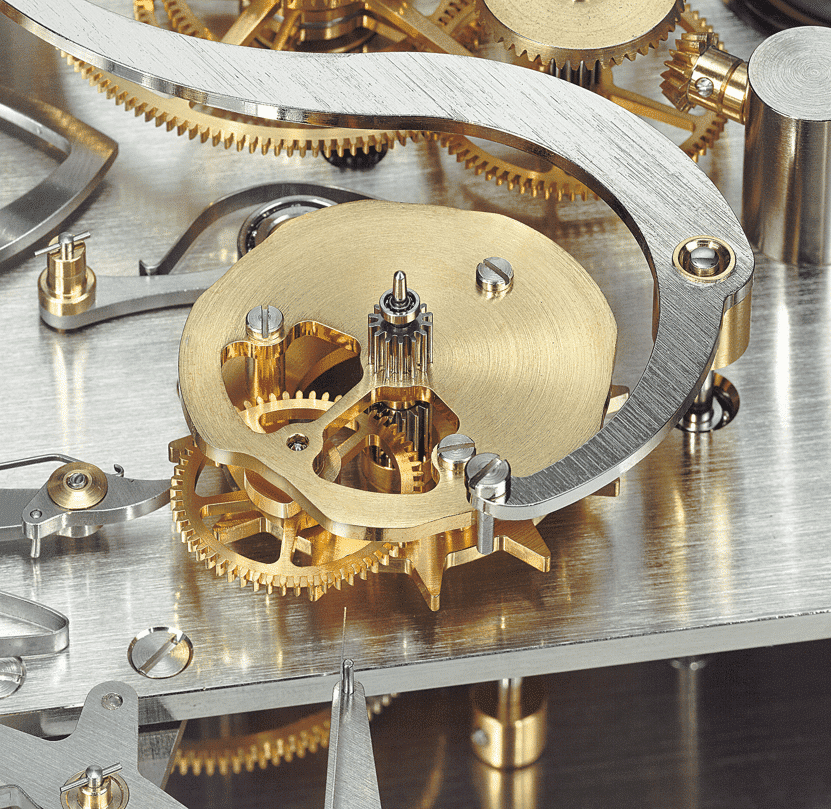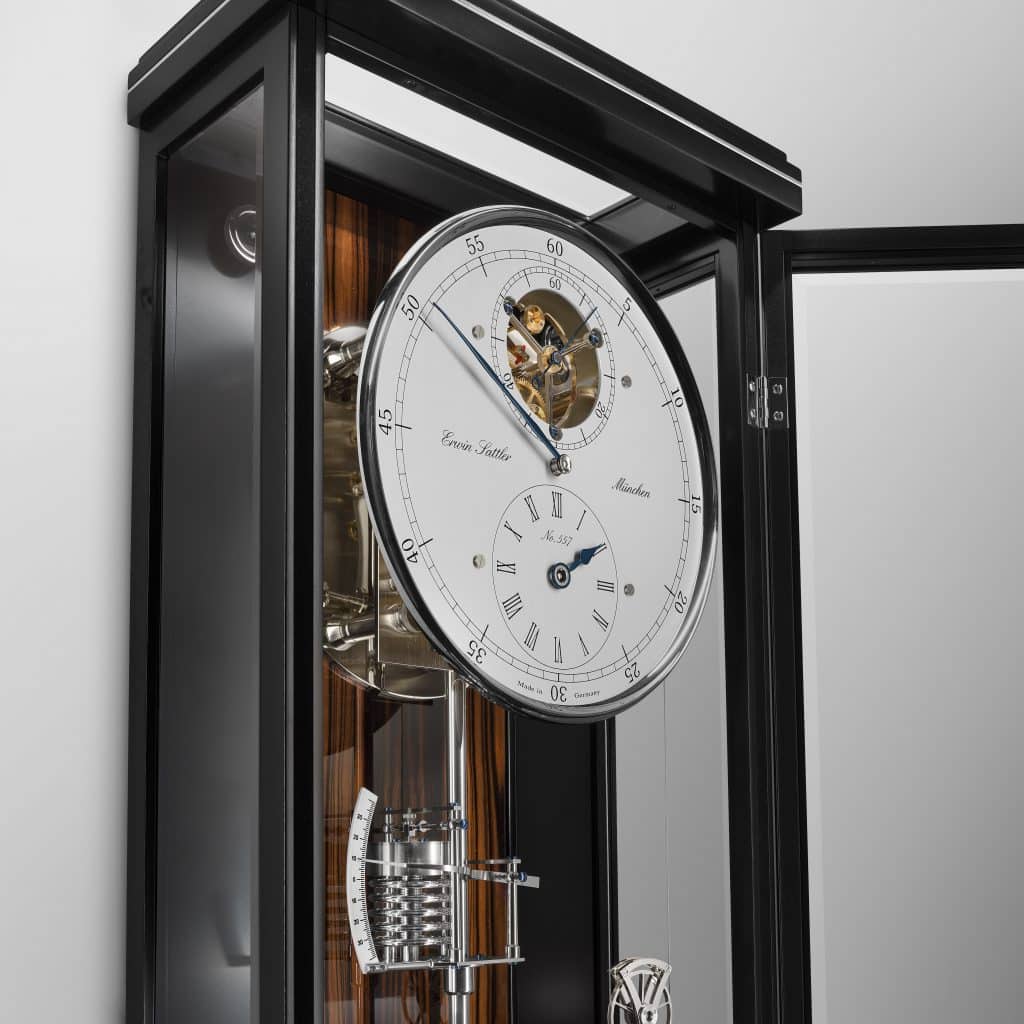The perpetual calendar – A technical masterpiece
Erwin Sattlers grandfather, Heinrich sattler, patented already on the 4th of March 1903 a desk or shelf clock with perpetual calendar. The model Opus Perpetual embodies the most modern interpretation of the perpetual calendar in Erwin Sattler’s collection. The impressive size, special design and modern aesthetics of this truly majestic precision pendulum clock make it an absolute masterpiece of craftsmanship. The timepiece gives the beholder all the information they could possibly need, lending precious time an attractive face with not only centrally positioned hands to indicate the hour, minute and second, but also an equally beautiful and stylish astronomical trio to show the day of the week, the month and the exact date.
Those who take a closer look at the artfully skeletonised dial will discover a fourth calendar display underneath the axis of the month indicator, with four fields marked 1, 2, 3 and L. Horophiles will know immediately that this is a display for three normal years and one leap year, which tells them that this complex work of art features a perpetual calendar − from which the Opus Perpetual takes its name. Those who adorn their living room or office with this mechanical masterpiece will, theoretically, without any further action on their part, be able to enjoy the intelligently designed calendar mechanism until the end of February 2100. This is when the Gregorian calendar, instituted in 1582, will require a minor correction to be made in order to program the indicators for the next 100 years through until 2200. Having a power reserve of 30 days means that the 601-part calibre 2051 calls for little in the way of attention. Should the timepiece stop when its proud owner is away for an extended period, the separate correctors make it easy to correct the day, month and date subsequently. The dial is further enhanced by a delightful three-dimensional moon phase display, on which the hand-painted rotating ball at the “12” bears a remarkable likeness to the mystical moon. Great importance is placed on the accuracy of the moon phase as well as on its appearance, however: This indication will not deviate a full day from the astronomical norm for another 122 years. A blue funnel-shaped sky disc provides a worthy background to the moon phase display, embellished as it is with ten small 0.1-carat diamonds to symbolise stars shining in the sky. Six further anniversary diamonds act as additional twinkling indices for the even-numbered hours.
The advancement of the Opus Perpetual’s eponymous calendar, which is made up of 130 components, is truly a masterstroke of engineering. For energy reasons, advancement takes several hours for other movements, with the hands moving from one position to the next very slowly. This is not the case with the sensational precision pendulum clock from Erwin Sattler, however, thanks to its special design. Its movement features a melodious strike train too, which announces the full and half hours with sound. A separate weight even guarantees propulsion over 30 days. Its mass generates enough force to advance the calendar mechanism to the next day in just 12 seconds − i. e. during the 12 strikes at midnight − and also to the next month. The precision of the movement therefore remains completely unaffected.
The strike train in the Opus Perpetual offers yet another special feature. In contrast to simple designs that have a countwheel, the elaborate rack and snail mechanism guarantees that the clock will strike the correct hour even if the hands are moved forwards or backwards without waiting for the sequence of chimes to finish. A tubular gong provides pleasant sound quality. Should the clock’s owner only wish to enjoy its soft ticking, however, the strike train can be suppressed with a simple hand movement.
The beating heart of the precision pendulum clock is the calibre 2051, which is made in-house. Comprising 601 components in total, it is one of the most complex movements that clock manufacturer Erwin Sattler has ever produced. It goes without saying all parts are made of the very finest materials available, finished with care and lovingly put together. The wheels rotate between solid brass plates that are 4 mm thick. An electroplated nickel coating provides protection against oxidation. To reduce the masses in motion, the 24 gold-plated gear wheels are spoked as much as is technically feasible and sit upon solid, fully hardened steel arbors with precisely milled pinions. 48 stainless steel precision ball bearings and four chatoned jewel bearings ensure almost frictionless rotation. These elaborate measures serve to achieve functional perfection, reducing energy loss to an absolute minimum. The George Graham lever escapement has two agate pallets. A seconds pendulum with a 12 mm-thick invar rod, a steel-nickel alloy with minimal thermal expansion coefficients and a steel element to compensate for unavoidable fluctuations in temperature act as an oscillator.
The accuracy of the pendulum clock can be affected by changes in the air pressure too, which is why the Opus Perpetual has a bilateral barometric compensator on the pendulum rod: When the air pressure rises, the aneroid capsules are pushed together. This causes the weights on the capsules to move downwards, shifting the entire pendulum’s centre of gravity accordingly. Similarly, the two weights are raised when the air pressure falls. The two tungsten weights (weighing 6,800 g each) for the gravity drive are attached to ball-bearing rope pulleys. These sophisticated structures have a positive effect on accuracy, and providing the Opus Perpetual is regulated carefully, its monthly drift is as low as one or two seconds.
The Opus Perpetual also takes its exceptional aesthetics from its attractive case, which protects and houses the technologically impressive movement. Made from massive aluminium, the 152 cm-high, 39 cm-wide, 22 cm-deep case will draw the eye to any wall it is placed against. The look is completed by a lively olive root wood cassette, while the pane of antireflective mineral glass provides a tantalising glimpse inside. On request, the cassette can also be made in a different wood or in carbon. To celebrate its anniversary fittingly, the Erwin Sattler manufacture is making only 60 Opus Perpetual timepieces. The number of each piece is indicated by a plaque at the “6” on the skeletonised dial.

The energy needed to control the calendar comes from the strike train. The advantage of this design is that the actual process of changing the day, date and month takes place during the 12 o’clock chime exactly at midnight and only lasts about 15 seconds.

An interesting yet technically functional moment: The date wheel is almost at the month changeover point.

The year wheel combined with a four-year wheel reliably keeps track of the extra day in February in leap years.
Post from








